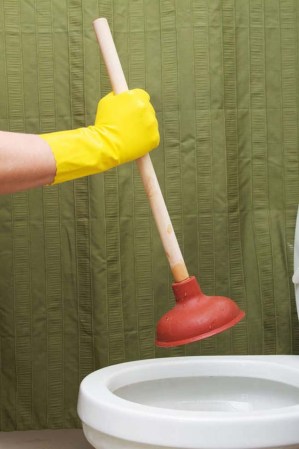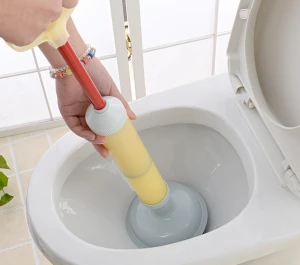Using Plunger and Drain Cleaners: Pro Advice
Using Plunger and Drain Cleaners: Pro Advice
Blog Article
This great article on the next paragraphs in relation to How To Use Your Toilet Plunger Correctly in 5 Easy Steps is truly engaging. Read on and make your own ideas.

Introduction
Correct upkeep of home drains is essential for protecting against obstructions and making sure smooth water flow. Among the secret tools in every home owner's toolkit is the bettor, along with different drainpipe cleansers developed to take on stubborn obstructions properly. This write-up checks out just how to use bettors and drainpipe cleansers effectively to keep your drains moving openly.
Area 1: Recognizing Plungers
Types of Plungers
There are several types of bettors offered, each developed for different sorts of drains pipes and blocks. The most usual types include mug plungers, flange bettors, and accordion plungers.
How Plungers Job
Plungers work with the principle of developing pressure and suction to displace blockages. When properly used over a drainpipe, they produce a vacuum cleaner that can pull out particles or separate obstructions.
Choosing the Right Bettor
Choosing the appropriate bettor depends upon the kind of drain and the nature of the clog. Mug bettors are excellent for sinks and bathtubs, while flange bettors are better suited for commodes due to their design.
Usual Blunders with Bettors
Staying clear of these errors makes certain effective plunging: inappropriate seal around the drainpipe, not enough pressure, and not clearing surrounding debris.
Area 2: Using Plungers Effectively
Preparation
Before plunging, ensure the bettor covers the drain completely and forms a tight seal. Clear any kind of noticeable particles around the drain opening.
Technique
Beginning with mild plunging movements to build suction. Rise stress gradually, making use of a consistent rhythm. Repeat as required till the drain clears.
Fixing Tips
If plunging does not function, try readjusting the seal, applying oil jelly for a better seal, or making use of a different kind of bettor.
Section 3: Comprehending Drainpipe Cleaners
Kinds Of Drainpipe Cleaners
Drain cleansers can be chemical or chemical. Chemical cleansers use strong chemicals to dissolve clogs, while chemical cleaners utilize natural enzymes to break down raw material.
How Drain Cleaning Company Work
Chemical cleaners react with obstructions to dissolve them, while chemical cleaners break down organic materials like hair and grease without damaging pipelines.
Safety Considerations
Always use gloves and eye protection when utilizing chemical drain cleaners. Make certain sufficient air flow and comply with producer instructions carefully.
Eco-Friendly Alternatives
Consider making use of vinegar and cooking soda or enzyme-based cleansers for green choices that are safer for pipelines and the environment.
Area 4: Using Drainpipe Cleaners Successfully
Application Techniques
Put chemical cleaners straight into the drainpipe opening. Permit them to help the advised time before flushing with warm water. Chemical cleaners ought to rest over night.
Precautions
Avoid mixing various sorts of cleansers, as this can produce harmful fumes. Never ever make use of chemical cleansers in conjunction with a plunger, as splashing can occur.
Taking Care Of Stubborn Obstructions
For persistent blockages, consider utilizing a pipes snake or calling an expert plumbing professional to avoid damages to pipes.
Verdict
In conclusion, comprehending how to make use of bettors and drain cleansers properly is important for keeping healthy plumbing systems. By picking the right devices and methods, property owners can deal with small obstructions and protect against significant plumbing issues down the line.
How to Use a Plunger to Unclog a Drain
The humble plunger is a simple yet effective tool for breaking clogs in sinks, tubs and toilets. This handy tool is easy to use. You can make the most of its power if you understand how it works. Ready to dive in? Here’s what you need to know.
Safety First!
Never use a plunger with drain chemicals. Water will splash as you work, and the chemicals can spatter, burning skin and eyes. It’s a good idea to use rubber gloves and wear safety goggles when you work on a clog.
Choose the Right Tool for the Job
Plungers come in two different styles. Sinks, bathtubs and showers require a cup plunger. Like its name suggests, the rubber end is shaped like a cup. Use a flange plunger on toilets. These plungers have a rubber funnel extending from the cup. A plunger needs to be big enough to cover the drain.
Ready, Set, Plunge!
Coat the rim: Coat the plunger rim with petroleum jelly. This helps make a better seal.
Block outlets: Hold a wet rag over nearby outlets such as the overflow vent or the drain in a second sink.
Release air: Insert the plunger at an angle into the water. Water will displace air in the cup. A water-filled cup is more forceful than one filled with air.
Keep the plunger upright: Hold the plunger perpendicular to the drain. Use fast, forceful strokes, but make the first stroke gentle. The first stroke can create a splash if the cup still contains air. Thrust the plunger 15 to 20 times.
Snap off the plunger: The final stroke should be a strong upward motion that ends when the plunger snaps off the drain.
Repeat the process: you may need to repeat this sequence several times. When the water drains away, your work is done. High-five! https://plumbernw.com/blog/how-to-use-a-plunger-to-unclog-a-drain/

Application Techniques
Put chemical cleaners straight into the drainpipe opening. Permit them to help the advised time before flushing with warm water. Chemical cleaners ought to rest over night.
Precautions
Avoid mixing various sorts of cleansers, as this can produce harmful fumes. Never ever make use of chemical cleansers in conjunction with a plunger, as splashing can occur.
Taking Care Of Stubborn Obstructions
For persistent blockages, consider utilizing a pipes snake or calling an expert plumbing professional to avoid damages to pipes.
Verdict
In conclusion, comprehending how to make use of bettors and drain cleansers properly is important for keeping healthy plumbing systems. By picking the right devices and methods, property owners can deal with small obstructions and protect against significant plumbing issues down the line.
How to Use a Plunger to Unclog a Drain
The humble plunger is a simple yet effective tool for breaking clogs in sinks, tubs and toilets. This handy tool is easy to use. You can make the most of its power if you understand how it works. Ready to dive in? Here’s what you need to know.
Safety First!
Never use a plunger with drain chemicals. Water will splash as you work, and the chemicals can spatter, burning skin and eyes. It’s a good idea to use rubber gloves and wear safety goggles when you work on a clog.
Choose the Right Tool for the Job
Plungers come in two different styles. Sinks, bathtubs and showers require a cup plunger. Like its name suggests, the rubber end is shaped like a cup. Use a flange plunger on toilets. These plungers have a rubber funnel extending from the cup. A plunger needs to be big enough to cover the drain.
Ready, Set, Plunge!
Coat the rim: Coat the plunger rim with petroleum jelly. This helps make a better seal. Block outlets: Hold a wet rag over nearby outlets such as the overflow vent or the drain in a second sink. Release air: Insert the plunger at an angle into the water. Water will displace air in the cup. A water-filled cup is more forceful than one filled with air. Keep the plunger upright: Hold the plunger perpendicular to the drain. Use fast, forceful strokes, but make the first stroke gentle. The first stroke can create a splash if the cup still contains air. Thrust the plunger 15 to 20 times. Snap off the plunger: The final stroke should be a strong upward motion that ends when the plunger snaps off the drain. Repeat the process: you may need to repeat this sequence several times. When the water drains away, your work is done. High-five! https://plumbernw.com/blog/how-to-use-a-plunger-to-unclog-a-drain/

We were shown that editorial about Here's How to Correctly Use a Toilet Plunger through a good friend on another site. Sharing is caring. Helping people is fun. Many thanks for your time invested reading it.
Schedule A Service Call Report this page